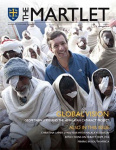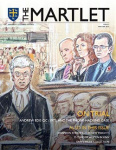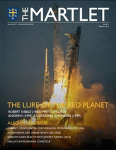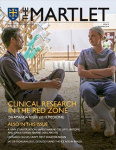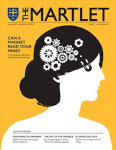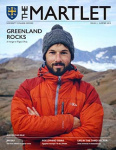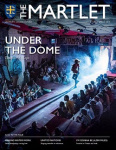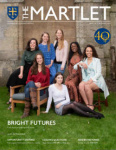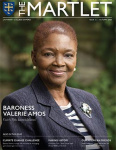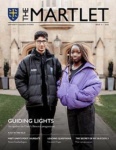Laura Stevens: Expedition data recovery
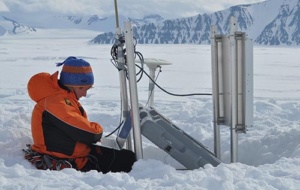
Downloading data from a GPS receiver (Photo: M. Chambers)
From October to December 2021, Dr Laura Stevens, Supernumerary Fellow in Climate and Earth Surface Processes, completed an expedition to Antarctica to retrieve data logged on instruments they helped set out two years ago. The various instruments and sensors Dr Stevens and colleagues installed out on the ice shelf are designed to monitor ice-shelf surface melt and how the ice shelf responds to movement and ponding of this surface meltwater. After a missed field season in November 2020 due to the COVID-19 pandemic, Dr Stevens travelled with Professor Ian Willis from St Catharine’s College, Cambridge, and Dr Becky Dell, a European Space Agency Climate Change Initiative Fellow and Postdoctoral Research Associate at the Scott Polar Research Institute at Cambridge, to unbury, service and retrieve data from the instruments.
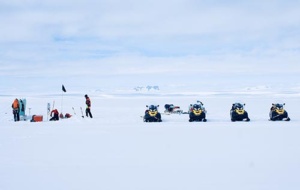
Working to recover a buried GPS receiver (Photo: B. Dell)
Following a two-week quarantine period with four PCR tests in the Falkland Islands, the expedition faced a further three-week delay waiting for a frozen runway at the British Antarctic Survey’s (BAS) Rothera Base to thaw. From Rothera, they travelled by Twin Otter a further 400 km into the icy continent to Fossil Bluff Field Station (BAS) on the edge of the George VI Ice Shelf, where they stayed for around three weeks. At Fossil Bluff and out on the ice shelf, the science team were additionally supported by Mr. Mark Chambers, an incredibly helpful mountaineer and field guide employed by the British Antarctic Survey. This team of four commuted daily onto the ice shelf by skidoo to uncover the Global Positioning System (GPS) antennae and receivers, water-level sensors, weather stations, and time-lapse cameras that have been operating continuously since November 2019. This year they also used a novel hot-ring corer to retrieve 10–15 m deep ice cores from the ice-shelf surface, before servicing and repositioning the GPS and weather-station instruments to collect one more years’ worth of observations. The team will return in November 2022 to pack them all up and bring them home.
Working with the project’s lead investigator Dr Alison Banwell (University of Colorado Boulder) and colleague Professor Douglas MacAyeal (University of Chicago), the team will use the data to examine in detail how much melting occurs across the ice shelf each summer, how much of that water ponds up in lakes, and how that ponding causes the floating ice shelf to bend and possibly crack under the weight of the meltwater. The team’s findings should improve our understanding of how ice shelves fracture and break up. Ice-shelf break up and decreasing ice-shelf stability is predicted to be more likely in the future as melting around Antarctica’s periphery increases, ultimately due to rising atmospheric temperatures from global warming.
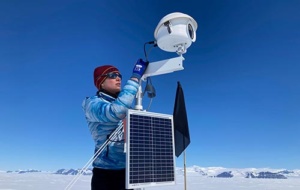
Dr Dell tightens up the bolts on a time-lapse camera mount (Photo: L. Stevens)
A recent study using satellite data led by Dr Banwell and co-authored by Dr Stevens and Dr Dell showed that 2019–20 was an exceptionally high melt summer, with more water ponded on the George VI Ice Shelf than at any time for the past three decades. The team was unable to revisit the sites in the 2020–21 summer because of COVID-19, making the 2021 visit all the more important. “Even with the missed field season in 2020–21, we’re really excited to look into the data we retrieved that extends across the exceptionally high melt summer of 2019–20,” Stevens said. “This was the most melt the George VI Ice Shelf had seen in at least 32 years, and to have had instruments out on the ice shelf during that summer is a remarkably useful concurrence.”
With the current 2021–22 melt season looking to finish up as a more moderate melt season, Stevens noted that the final year of data – in combination with the earlier 2019–20 observations – will provide a useful benchmark for how the ice shelf responds across the observable range of melting that the ice shelf experiences at present.
The work is funded by the UK Natural Environment Research Council, the US National Science Foundation and British Antarctic Survey Logistics.
This feature was adapted from one first published in Issue 14 of The Martlet; read the full magazine here or explore our back catalogue of Martlets below:
Published: 13 July 2022

